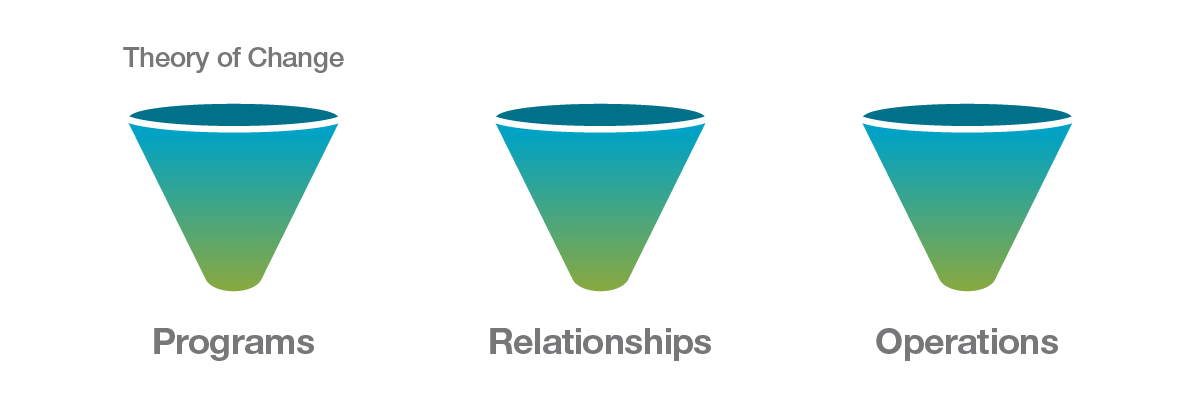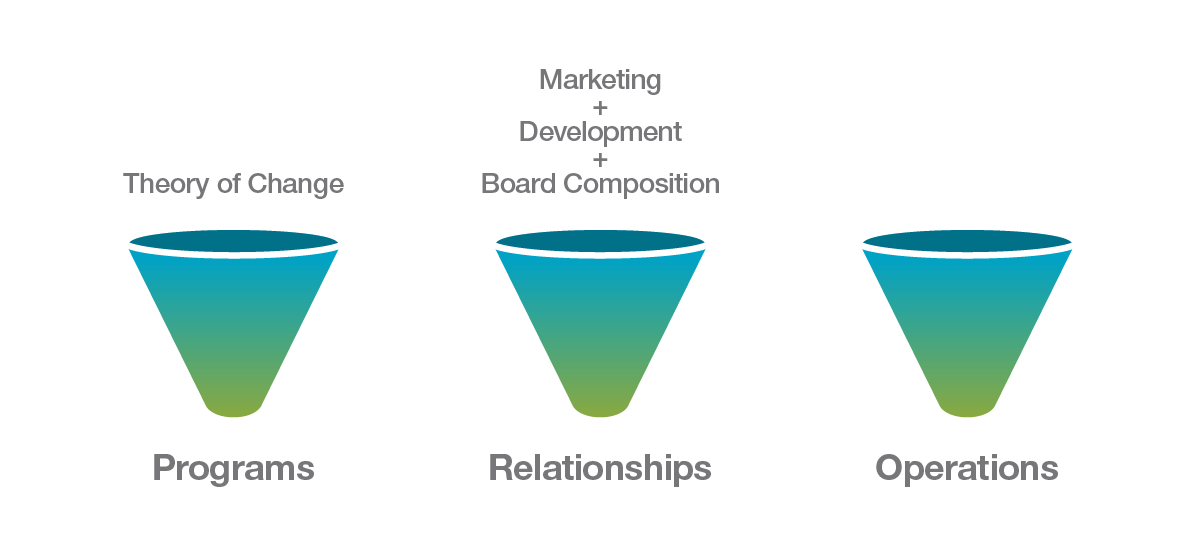In an earlier post, I shared a model, adapted from Brad Feld, that describes all contemporary organizations as having “three machines.”

Each of these machines is in fact a funnel—moving clients along a journey, turning interested parties into brand advocates and dollars into sustainable strategic advantage.

With a few nomenclature tweaks and clarifications, this model works not just for private sector organizations, but for nonprofits, too.
The Programs machine
Though some nonprofits sell products, most are primarily services businesses, so our Product machine needs a new name.
An arts organization might label this machine “Programming,” and some other nonprofits might use “Services” or “Offerings.” But “Programs” is the label that fits best for most nonprofits and matches the language that they already use.

A private sector professional coming to the nonprofit world for the first time will need to adjust their expectations for what the Programs machine actually produces. Whereas private sector organizations can measure their products and services success using metrics like NPS, MAU, and others, most nonprofit organizations can’t use those measures to evaluate their impact. Social sector organizations exist by definition to solve things the private sector can’t: the measures of success tend to be different.
As the economy tightens, and new technologies proliferate, there is a major trend in nonprofits to have quantitative, evidence-based outcomes data for their core programs. However, having rigorous impact data is desirable but not always fully possible: for example, the data might be fiendishly difficult or expensive to collect, or no dominant paradigm may exist to know what kind of data to track; outcomes replicability across widely varying contexts might be a serious challenge, etc. etc.
To navigate these ambiguities and uncertainties, many social sector organizations articulate a specific Theory of Change. “Theory of Change” is the standard terminology to describe the intent of a nonprofit intervention or suite of interventions. The Theory of Change describes, unifies, and prescribes a nonprofit’s program strategy and also determines its program success measures. It’s equivalent to “product strategy” in the private sector. The ToC may or may not be evidence-based or fully evidence-based—i.e., it might be speculative. Hence, it’s a theory. Over time, ideally both the theory and the execution could be tested.

Note: A ToC is often critical to securing funding, since major private and corporate donors typically invest in organizations that reflect their own Theory of Change.
Nonprofit Relationship functions
Like any organization, a nonprofit needs to maintain tight relationships with a wide range of external stakeholders—strategic partners, community leaders, press, employee recruits—but the three relationship activities that tend to matter the most for most nonprofits are Marketing, Development, and Board Composition:
- Marketing is critical to communicate clearly the value and unique point of view of the organization.
- Development (aka fundraising) is critical to secure revenue from appropriate, segmented, and prioritized sources.
- Board Composition is important to ensure that the leadership of the organization advances those messages credibly while supercharging the efforts of the staff.

In his many excellent books, Michael Kaiser describes how the proactive, ongoing refreshing and up-leveling of nonprofit boards is essential to ensuring organizational health:
“Unfortunately, many of the board members who were helpful when the company was founded may not be able to give or develop resources; different skills are required. But too many organizations do not explicitly recognize the need for change, and the members of the board not able to make the transition are allowed to stay on indefinitely.” – Michael Kaiser, Leading Roles
Kaiser also talks about how institutional marketing and programmatic marketing must both be strong, and work together—an insight that has obvious parallels to the private sector. (See my previous posts on product marketing and growth marketing.) As was true for the private sector, this distinction between program, institutional, and performance marketing layers naturally across our “three machines” model:

- Institutional marketing = promoting our organization’s long-term revenue and brand (e.g., the San Francisco Opera)
- Program marketing = promoting individual programs (e.g., this season’s production of Romeo and Juliet)
- Performance marketing = optimizing short-term revenue (e.g., Friday night ticket sales)
Balancing these three kinds of marketing, as always, involves difficult tradeoffs in messaging, channel investment, and funding predictability.
Note: The Relationships machine could also be labeled Revenue. Both names work equally well.
Putting it all together
When I work with nonprofits, I often use this “three machines” model diagnostically to assess where an organization is strong and where it has room for improvement. Some organizations I work with have very solid programs but no operational engine to scale their business. Some have strong marketing engines but weak boards (or vice versa). The three machines model makes it easy to isolate what’s working well and what’s not.
But the three machines don’t work just isolation—they need to work together synergistically for an organization to maximize its longevity and impact.

Michael Kaiser once again talks about a Cycle that connects an arts organization’s programs to an ever-expanding, ever-deepening “family” of supporters, who in turn drive a stable and scalable financial model. This same basic idea applies, I think, to all nonprofits. Finding this cycle, synergy, or flywheel is key to maximizing a nonprofit’s long-term opportunity.
Nonprofits have several different filters they can apply to discover and define bold, integrated strategies:
- Mission: Why do we exist? What is our primary interest and moral responsibility and how does that deepen, expand, or shift over time?
- Vision: What is the external impact we seek to create? Are we stretching from a short-term, known opportunity into new areas? Could we?
- Theory of Change: How does our Theory of Change guide us to decide what we do and what we don’t do? What new hypotheses could we test for the good of our populations served and/or for the many other organizations doing cause-based work in our space?
- Development: What are the fundraising realities of our space? What are the requirements of the private and public funding sources we currently enjoy or potentially could, with organizational changes?
- Operations: As a nimble, small organization, what can we do uniquely well? Or, as a larger organization with significant infrastructure, what worthy goals can we take on that will lead to greater impact or more efficient allocation of philanthropic capital—particularly in today’s challenging economic and technological landscape?
- Core Group: Do we have the right team in place internally and on our board? Is who we are limiting what do we do, and if so, how do we need to evolve our board composition to better serve our mission?
- Leadership: What new business partnerships, business models, ventures, and programs can we envision that connect our three machines in new and powerful ways?
The need for leadership is critical: solid strategy development requires a leader who can see unique opportunities and marshal resources and energy to pursue them, working against the homeostatic internal culture.
Closing thoughts
I work extensively with both for-profit and nonprofit businesses, and I think it’s helpful to have models that apply equally well to both. The two sectors are deeply intertwined and must become even more so to pursue worthy societal goals.
For those who have been following The Next Us for a long time, you know that this “three machines” model is the culmination of a long series of frameworks related to vision, business strategy, audience segmentation, brand strategy, marketing strategy, marketing planning, and board optimization. With occasional tweaks here and there, all of these component frameworks work equally well for private sector and social sector businesses.
Nonprofits, indeed, are fundamentally businesses. They sometimes have a reputation for being fluffy and unfocused, but in reality, they are highly entrepreneurial, perhaps even more so than private sector organizations:
“Effectuation is an idea with a sense of purpose – a desire to improve the state of the world and the lives of individuals by enabling the creation of firms, products, markets, services, and ideas… Effectuation articulates a dynamic and iterative process of creating new artifacts in the world. Effectual reasoning is a type of human problem solving that takes the future as fundamentally unpredictable, yet controllable through human action; the environment as constructible through choice; and goal as negotiated residuals of stakeholder commitments rather than as pre-existent preference orderings.” – Society for Effectual Action, Batten Institute, UVa. Darden Graduate School of Business


Leave a Reply